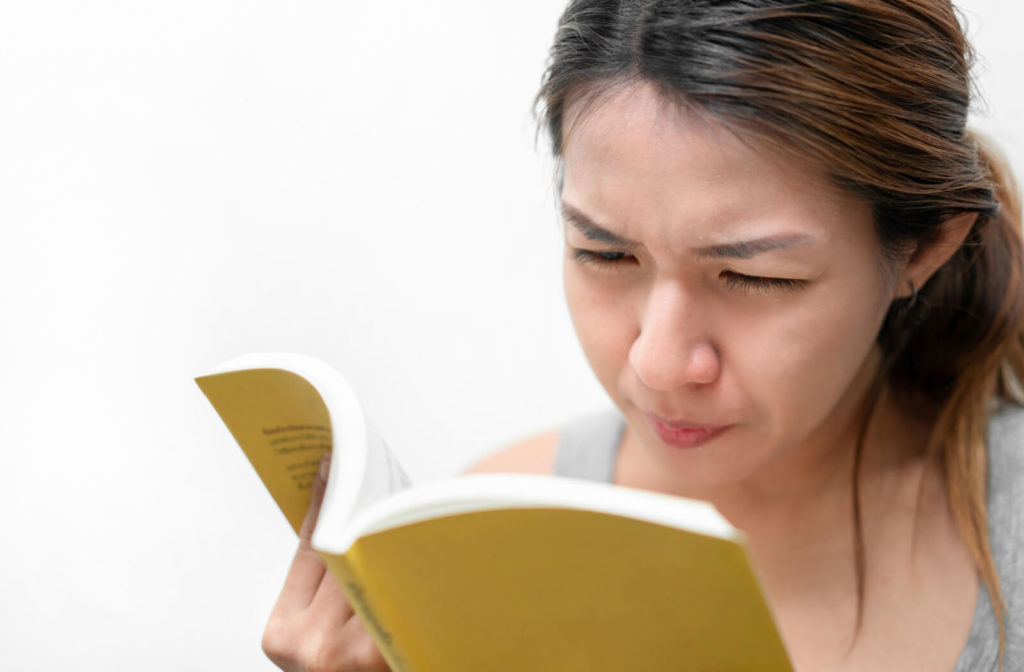A Growing Eye Problem
Myopia or nearsightedness is one of the most common vision problems, and it’s only growing. Myopia affects over 30% of Canadians today, but health experts predict that 52% of the global population will be myopic by 2050.
There’s more to nearsightedness than needing glasses or contact lenses to watch TV. Myopia is one of the leading causes of legal blindness. Myopia is also progressing faster and developing earlier in children.
Managing myopia progression from an early age can help prevent vision loss. It’s also crucial to visit your optometrist for routine eye exams throughout your life to monitor changes to vision and eye health.
What Is Myopia?
Myopia (nearsightedness) is a refractive error, a type of vision condition caused by an irregular eye shape. Someone with a steeply curved cornea (front of the eye) or too-long eyeball (lengthwise) experiences blurry distance vision.
Picture a see-through round rubber ball and imagine shining a flashlight through. Light can easily shine from the front end to the back. Now imagine stretching the ball lengthwise until it’s shaped like a football. Light still shines through the eye, but the light is weaker, scattered throughout the ball instead of directly reaching the back.
Because of the elongated shape of a myopic eye, light can’t effectively reach the retina located at the back of the eye. The retina is delicate, light-sensitive tissue that uses light to create visual information, including detecting colour and light intensity.
There are degrees of severity. For example, someone with mild myopia may be able to complete most daily tasks without glasses or contact lenses. On the other hand, someone with moderate to high myopia may need to wear glasses consistently or require a strong prescription to see faces across a room.
Moderate to high myopia can significantly increase eye health risks. As the eyeball grows, it stretches tissue in the eye, decreasing distance vision and leading to various eye conditions, including:
What Causes Myopia?
Multiple factors can contribute to myopia, but it is often associated with heredity. If at least one parent is myopic, their child will likely inherit the condition.
Other risk factors include:
- Frequent visual stress – Prolonged hours with close-vision tasks or detailed work (including reading, computer work, or studying) can temporarily cause nearsightedness or worsen myopia long-term.
- Health conditions – Conditions such as diabetes can affect the health and function of eye tissue, causing vision changes, including nearsightedness
- Prolonged screen time – Studies have linked too much screen time (7 hours+ per week) in school-age children to a significantly increased risk of myopia.
Myopia is usually diagnosed in childhood when the eye is still growing. Vision changes typically slow or stabilize around age 20–21 because the eyeball stops growing. However, myopic progression can continue into adulthood. Myopia onset can also begin in early adulthood.
Managing Myopia
Myopia cannot be reversed or cured, but there are options for managing risk factors or preventing worsening myopia. For example, some adults may be candidates for laser eye surgery, such as LASIK or PRK, which can correct eye shape. However, regression and vision changes can still occur after corrective surgery.
Traditional glasses or contact lenses can support vision but cannot prevent factors contributing to myopia progression. For example, spectacles can help you comfortably see a movie theatre screen but won’t stop prolonged screen time from causing visual stress.
Myopia control moves beyond traditional means of enhancing vision. Instead, it involves tools and techniques to slow eye growth and limit risk factors. Managing myopia in childhood can have the greatest benefit, as it can prevent patients from developing higher degrees of nearsightedness.
Atropine Eye Drops
Atropine eye drops have been involved in eye care for over a century. Low-dose atropine eye drops are often used in dilated eye exams, as the drops help relax the eye and widen the pupil, allowing eye doctors to see inner eye tissue more easily.
The same way atropine helps relax the eye for an examination is how it slows eye growth. The low-dose eye drops, ranging from 0.01% to 0.05% atropine, prevent eye muscles from contracting, relieving focusing fatigue from visual stress. Some studies have found atropine can slow eye growth by 64.5%.
Multifocal Contact Lenses
Traditional contact lenses help refocus light to reach the retina, but multifocal contact lenses more effectively control scattered light to stop eye growth. The soft contact lenses feature 2 zones:
- The centre zone that focuses light to correct distance vision
- The outer ring that refocuses peripheral light to slow eye growth
One study found that daily disposable MiSight contact lenses could reduce myopic progression by up to 59%.
Multifocal Eyeglasses
For children who have difficulty handling contact lenses or may not be good candidates, multifocal eyeglasses for myopia are a more comfortable option. The myopia glasses work similarly to multifocal contact lenses, with 2 separate zones designed to correct vision and refocus peripheral light.
A 2-year clinical study featuring MiYOSMART found the lenses reduced myopia progression by 60% when compared to traditional glasses.
Learn More About Myopia
Although myopia cannot be reversed, there are things you can do to protect your eye health and preserve your vision. Contact us at Queensway Optometric Centre today to discuss your vision and eye health. We strive to support our patients with quality solutions and friendly, personalized care.


